Top 5 Hub Centric Rings to Eliminate Wheel Vibration
Introduction to Hub Centric Rings
If you’ve recently upgraded your vehicle with aftermarket wheels and noticed a persistent vibration, you’re not alone. Many drivers encounter this issue, especially when the wheel doesn’t perfectly match the vehicle’s hub diameter. That’s where hub centric rings come into play—a simple yet crucial component that ensures your wheels are properly aligned and centered.
Hub centric rings are specially designed inserts that fit between the wheel’s center bore and the vehicle’s hub. Their primary purpose is to fill the gap caused by a mismatch in sizing, allowing the wheel to sit perfectly centered on the hub. Without this alignment, even a minor off-center fitment can lead to noticeable shaking or vibration, particularly at higher speeds.
These rings are typically made from either plastic or aluminum, and they come in various size combinations to suit different vehicle and wheel specifications. While plastic options are lightweight and corrosion-resistant, aluminum rings are often favored for their strength and durability, especially in performance or high-mileage applications.
What makes hub centric rings indispensable for car enthusiasts and mechanics alike is their role in achieving a vibration-free ride and extending the lifespan of wheel components. Poorly centered wheels can cause uneven tire wear, stress on suspension parts, and an overall decline in driving comfort.
Whether you’re a DIY enthusiast installing your own wheels or a seasoned mechanic aiming for perfect balance, understanding the function and value of hub centric rings is the first step toward smoother, safer driving.
How Hub Centric Rings Work
To understand how hub centric rings function, it’s important to grasp the relationship between a vehicle’s hub and the wheel it mounts. The hub is the central part of the wheel assembly that connects to the axle. Every hub has a specific diameter—called the hub bore—designed to fit snugly with the wheel’s center bore.
When you use aftermarket wheels, the center bore of the new wheel may be larger than your vehicle’s hub. This creates a gap that prevents the wheel from sitting perfectly centered. Even though lug nuts can hold the wheel in place, they don’t always guarantee perfect alignment—this is where hub centric rings come in.
What Do They Actually Do?
Hub centric rings fill the space between the wheel’s center bore and the vehicle’s hub, creating a tight fit that centers the wheel exactly where it should be. By eliminating the gap, these rings ensure that the wheel is aligned concentrically with the hub. This alignment is crucial to prevent any imbalance that could result in:
- Steering wheel vibration
- Uneven tire wear
Stress on suspension components
Plastic vs. Aluminum Hub Rings
There are two primary materials used in hub centric rings:
Plastic (Polycarbonate)
- Lightweight and affordable
- Resistant to rust and corrosion
- Easier to install and remove without damage to the hub
Aluminum (CNC-Machined)
- More durable and heat-resistant
- Ideal for high-performance or heavy-duty vehicles
- Less prone to deformation during high-speed driving or frequent installations
Installation Mechanics
Installing a hub centric ring is straightforward. The ring is pressed into the wheel’s center bore or onto the vehicle’s hub, depending on the fit. Once installed, the wheel is mounted over it, allowing the ring to guide the wheel into perfect alignment. This ensures that the lug nuts are only responsible for clamping the wheel, not for centering it.
Key Benefits of Using Hub Centric Rings
Though they may seem small and inexpensive, hub centric rings deliver a surprising number of advantages for anyone using aftermarket wheels. Whether you’re a performance enthusiast or just want a smooth ride, these simple components can make a world of difference.
1. Eliminate Steering Wheel Vibration
One of the most immediate and noticeable benefits is the reduction or elimination of steering wheel shake, especially at higher speeds. When wheels aren’t perfectly centered, even the slightest misalignment can cause vibrations. Hub centric rings help ensure the wheel is positioned precisely, improving stability and comfort during every drive.
2. Improve Ride Quality
By correcting the fitment between the wheel and the hub, these rings help maintain consistent tire-to-road contact. This results in a more refined ride quality, especially on uneven roads or during cornering. The car feels more planted, and the drive becomes more enjoyable.
3. Extend Tire and Suspension Lifespan
Vibration and misalignment don’t just affect comfort—they also wear down your tires and suspension faster. Hub centric rings promote even tire wear and reduce stress on components like wheel bearings, bushings, and ball joints. That means fewer repairs and replacements over time.
4. Protect Lug Nuts and Studs
When wheels aren’t properly centered, the lug nuts can bear uneven loads. Over time, this can lead to loosened or stripped threads. Using hub centric rings ensures that the lugs are used only for securing the wheel, not for centering it. This reduces the risk of damage and improves safety.
5. Easy and Affordable Upgrade
Unlike many car upgrades, hub centric rings are incredibly affordable—typically under $25 for a set of four. They’re also easy to install, requiring no specialized tools or mechanical knowledge. It’s a low-cost solution with high-impact results.
6. Enhanced Aesthetic Fitment
In some cases, incorrectly centered wheels may sit slightly off-balance or look out of place. Hub centric rings help wheels align more flush with the hub, giving your vehicle a cleaner, more professional appearance.
What to Look for Before Buying Hub Centric Rings
Choosing the right hub centric rings is crucial for both performance and safety. A poor fit can lead to the very problems these rings are meant to solve—vibration, misalignment, and premature wear. Here’s what you should consider before hitting that “Buy Now” button:
1. Correct Sizing (Hub ID and Wheel OD)
The most important factor is matching the inner diameter (ID) of the ring to your vehicle’s hub size and the outer diameter (OD) to your wheel’s center bore. These measurements must be exact.
For example:
- A ring labeled 57.1 → 66.6 mm is meant for a 57.1 mm vehicle hub and a 66.6 mm wheel bore.
- Using the wrong size will render the ring ineffective and potentially dangerous.
Pro Tip: You can find these measurements in your vehicle’s manual or by contacting the wheel manufacturer.
2. Material Type: Plastic vs. Aluminum
Each material has its pros and cons:
- Plastic (Polycarbonate): Resistant to corrosion, lightweight, budget-friendly. Great for casual drivers.
- Aluminum (CNC-Machined): More durable and heat-resistant. Ideal for high-performance or heavy-load conditions.
If you change wheels often or live in hot climates, aluminum may be worth the small extra cost.
3. Vehicle and Wheel Compatibility
Ensure that the ring is compatible not just by measurement, but also by application. Some vehicles, especially European models like Audi, BMW, or VW, may require more precise tolerances. Double-check the ring’s compatibility with your make, model, and year.
4. Brand Reputation and Reviews
Stick with reputable brands known for quality control and precision engineering. Look for:
- Verified customer reviews
- Consistent ratings (ideally 4★ and above)
- Photos and real-world usage feedback
Brands like StanceMagic, Circuit Performance, and ZHTEAP are commonly trusted by auto enthusiasts.
5. Ease of Installation
While hub centric rings are generally easy to install, some are more user-friendly than others. Aluminum rings, for instance, may require a bit more finesse or anti-seize lubrication to prevent sticking over time.Look for options that offer a flush fit and don’t require modifications, especially if you’re installing them yourself.
Top 5 Hub Centric Rings Reviewed
After evaluating dozens of hub centric rings using our strict review criteria, we’ve narrowed it down ducts available on Amazon. These selections are based on real-world usage, verified customer feedback, and technical quality. Here’s our expert breakdown:
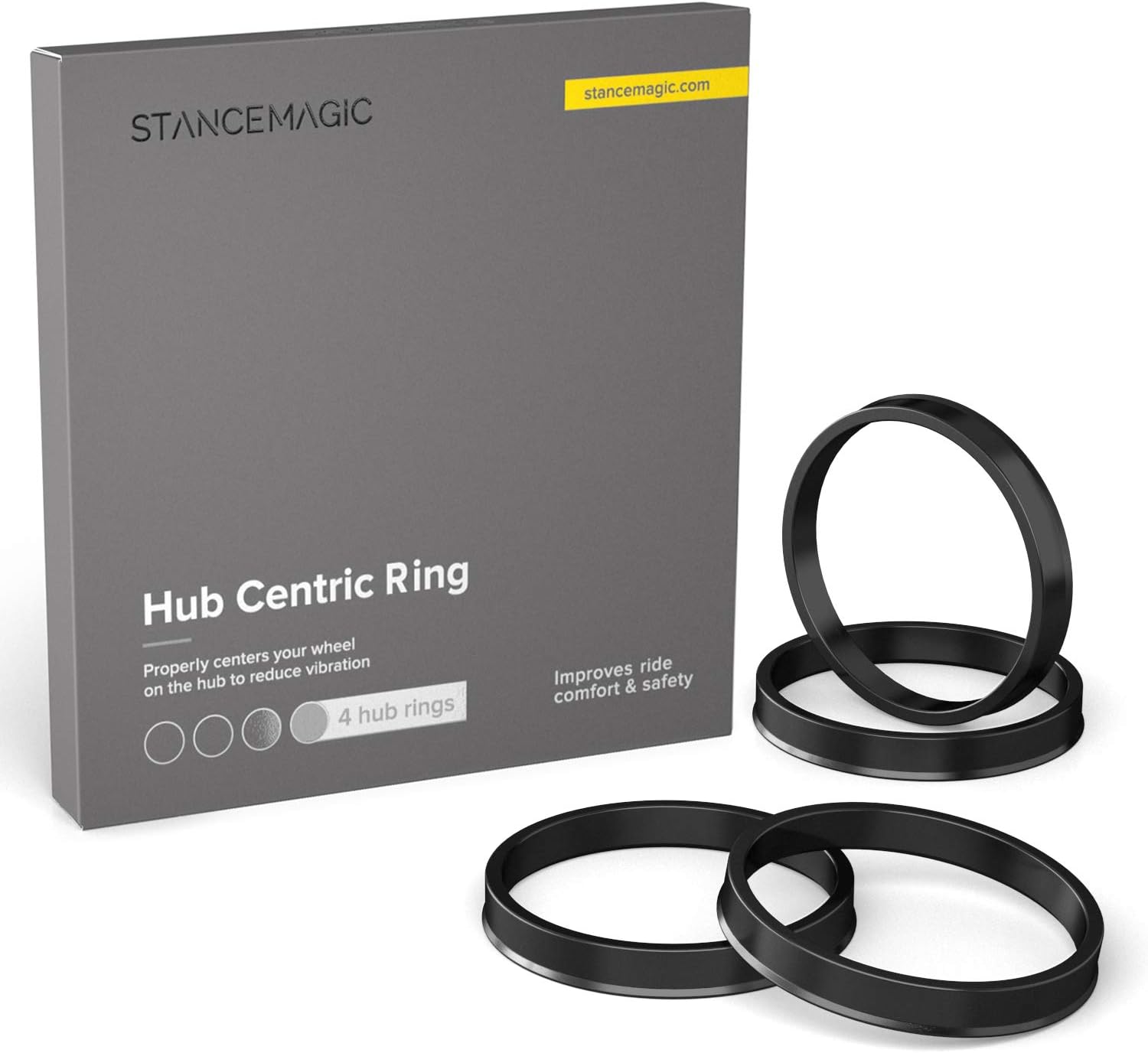 Detailed view of ring showing how to align with vehicle hub and wheel bore.
Detailed view of ring showing how to align with vehicle hub and wheel bore. 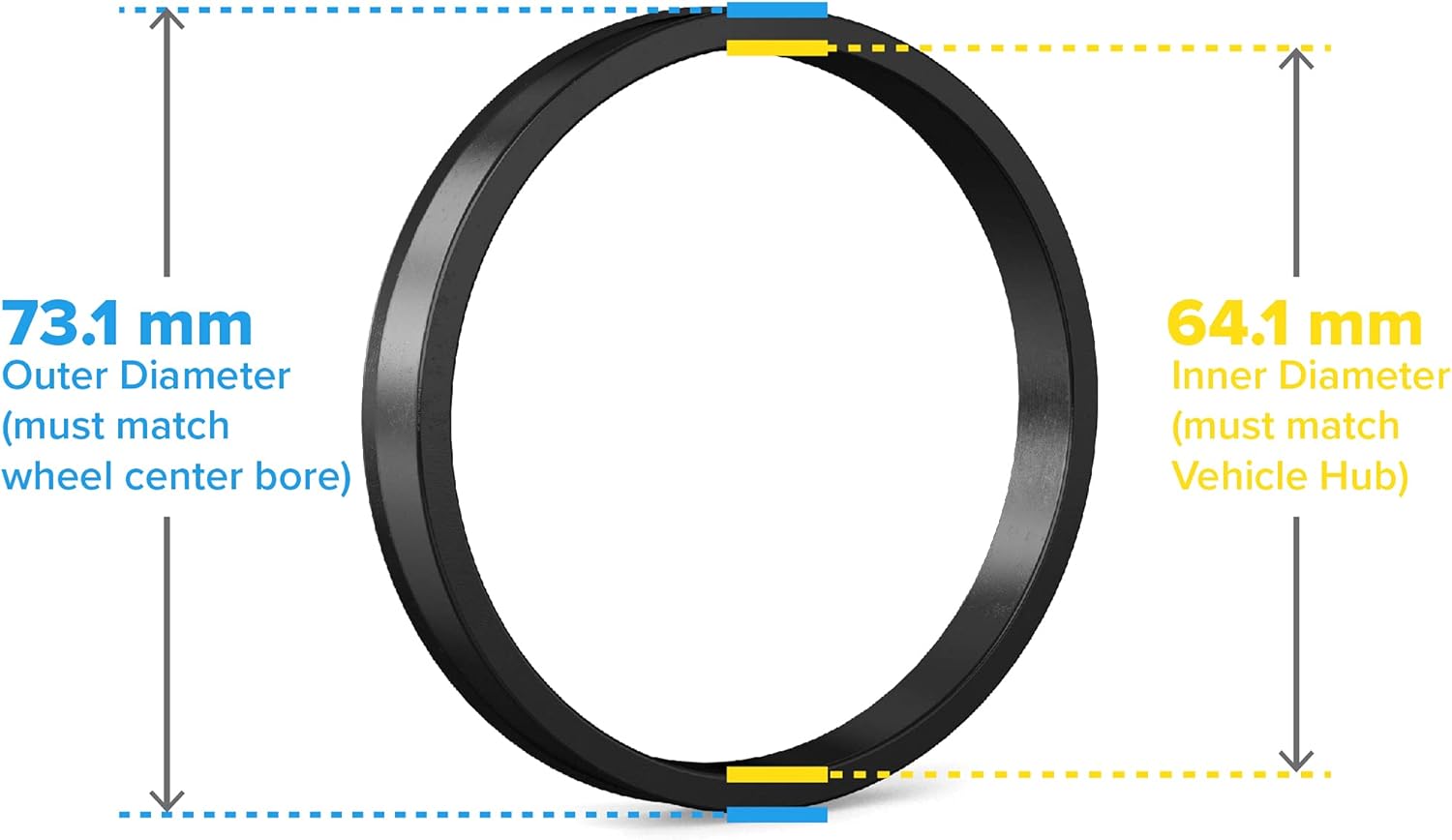 Ensure your wheel’s center bore is 73.1mm and vehicle hub lip is 64.1mm.
Ensure your wheel’s center bore is 73.1mm and vehicle hub lip is 64.1mm. 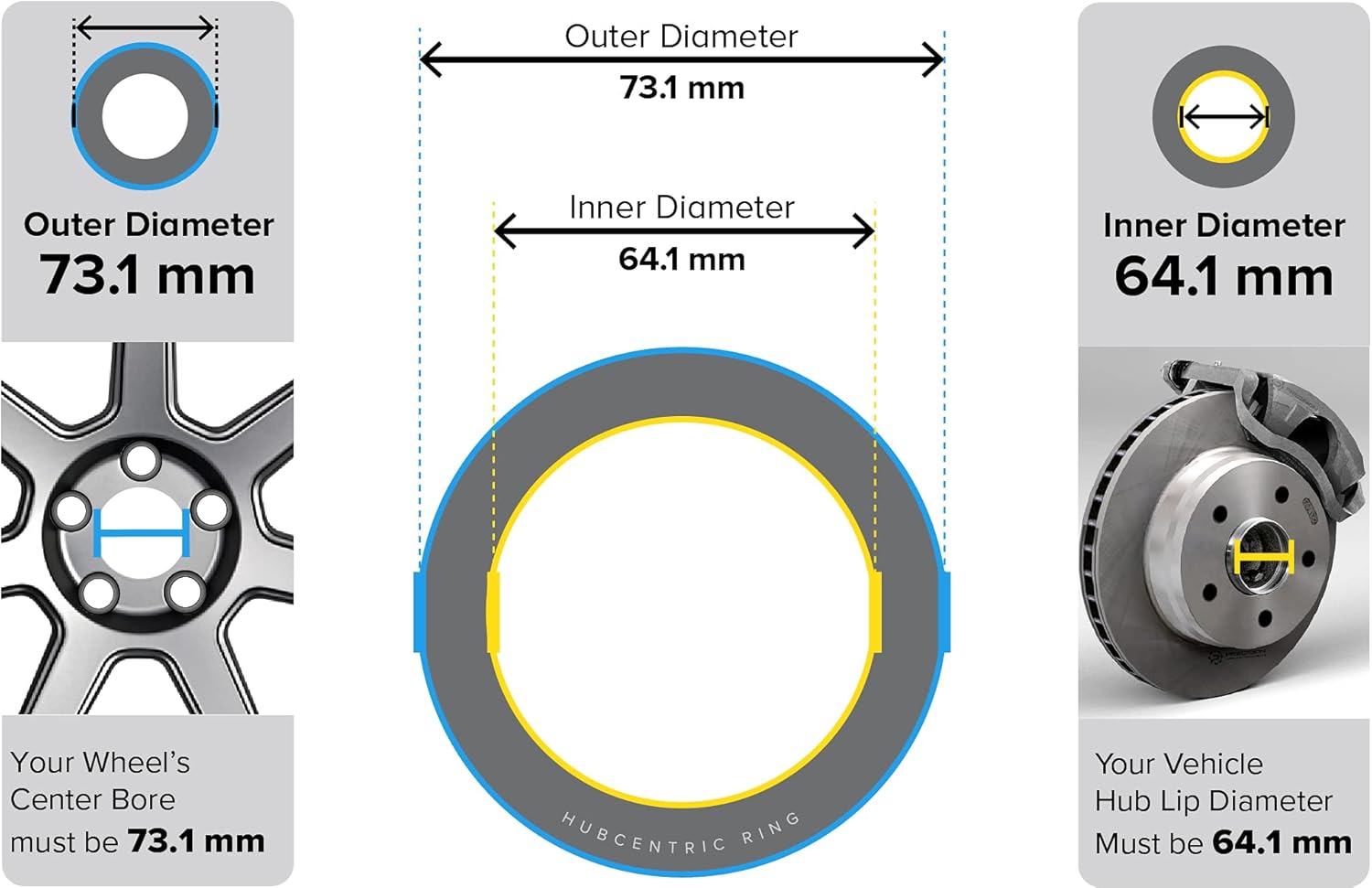



Product Overview
This pack of 4 hub centric rings is designed to adapt wheels with a 73.1 mm center bore to vehicles with a 64.1 mm hub bore. Made from durable polycarbonate plastic, these rings offer a tight, vibration-free fit ideal for aftermarket wheel users.
Best For
- Budget-conscious buyers
- Casual drivers
- Honda, Acura, and Tesla owners
Key Features & Benefits
- Precision fit to eliminate wheel vibration
- Lightweight and corrosion-resistant material
- Easy to install and remove without tools
- Helps prevent uneven tire wear
Pros & Cons:
- Affordable price point
- Resists rust and weather
- Effective for most commuter cars
- Less durable than aluminum rings
- Can deform if over-tightened
- Not suitable for performance driving
Who Should Buy These?
These rings are perfect for anyone looking for an economical way to reduce steering wheel vibration after installing aftermarket wheels—especially those driving sedans or compact cars with moderate usage needs.
StanceMagic Hubcentric Rings (57.1 → 66.6 mm, Pack of 4 – Aluminum)
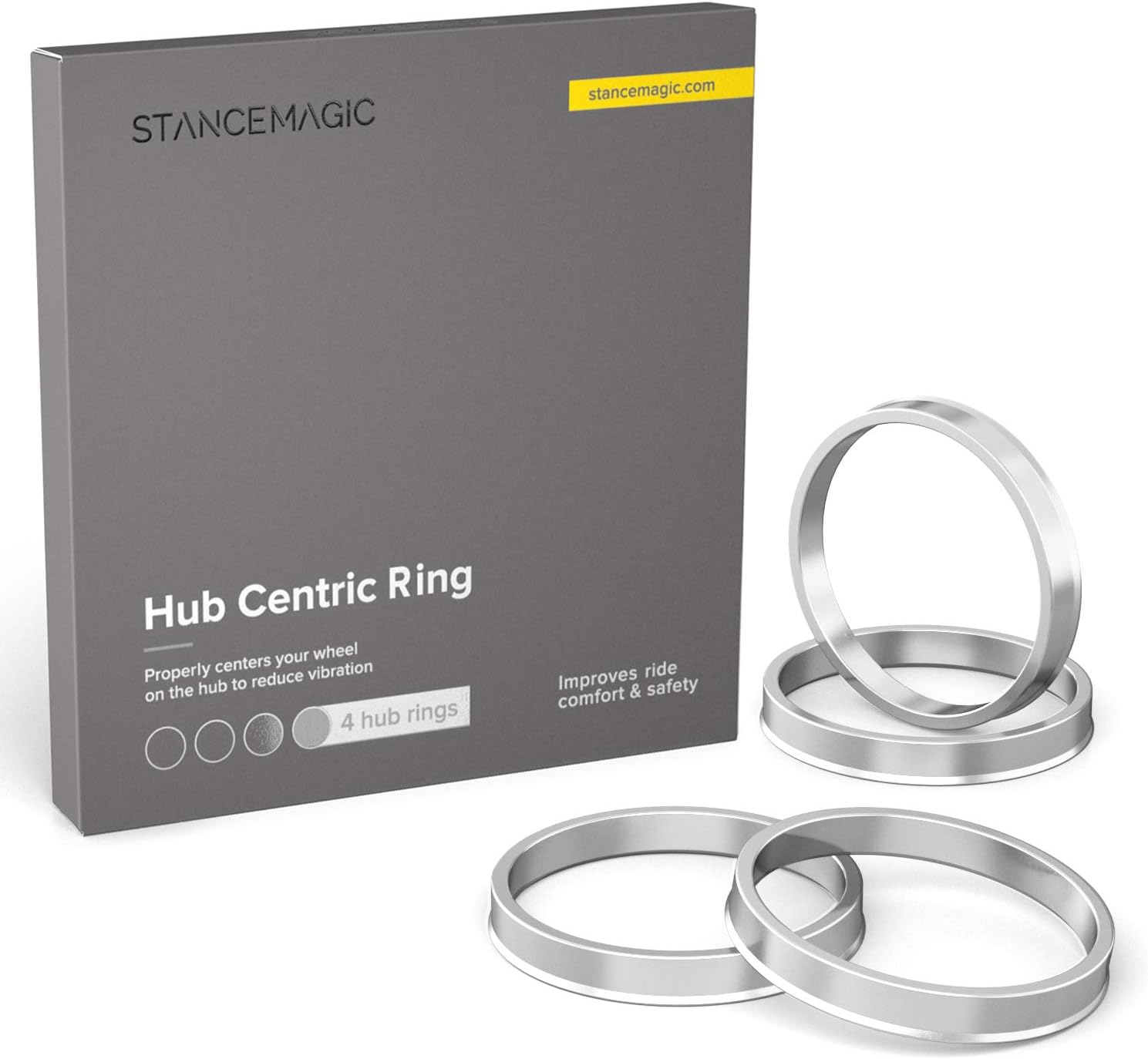 Clear depiction of how the ring fits between wheel and hub for proper centering.
Clear depiction of how the ring fits between wheel and hub for proper centering. 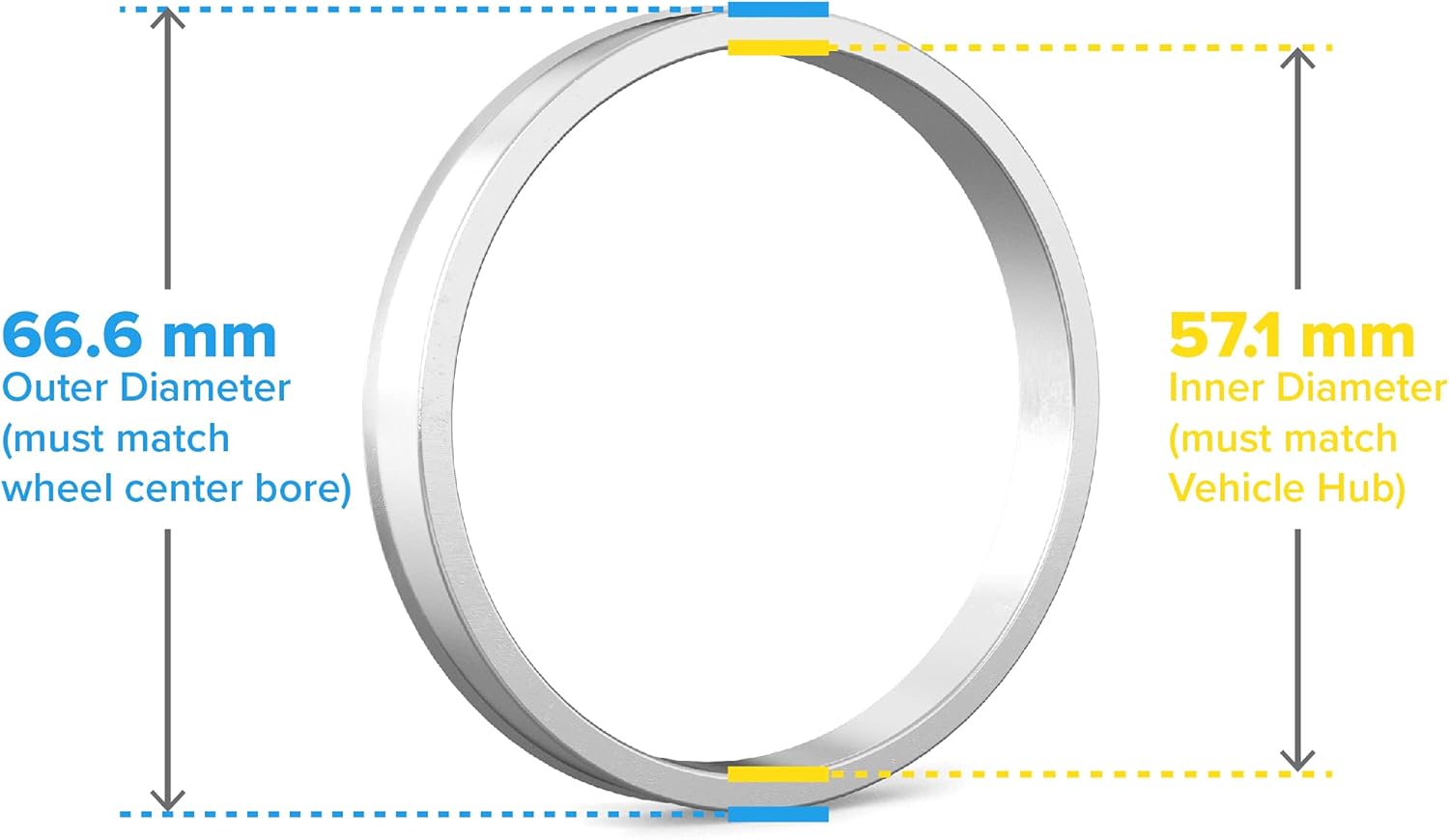 Match your wheel bore of 66.6mm to a vehicle hub of 57.1mm using this ring.
Match your wheel bore of 66.6mm to a vehicle hub of 57.1mm using this ring. 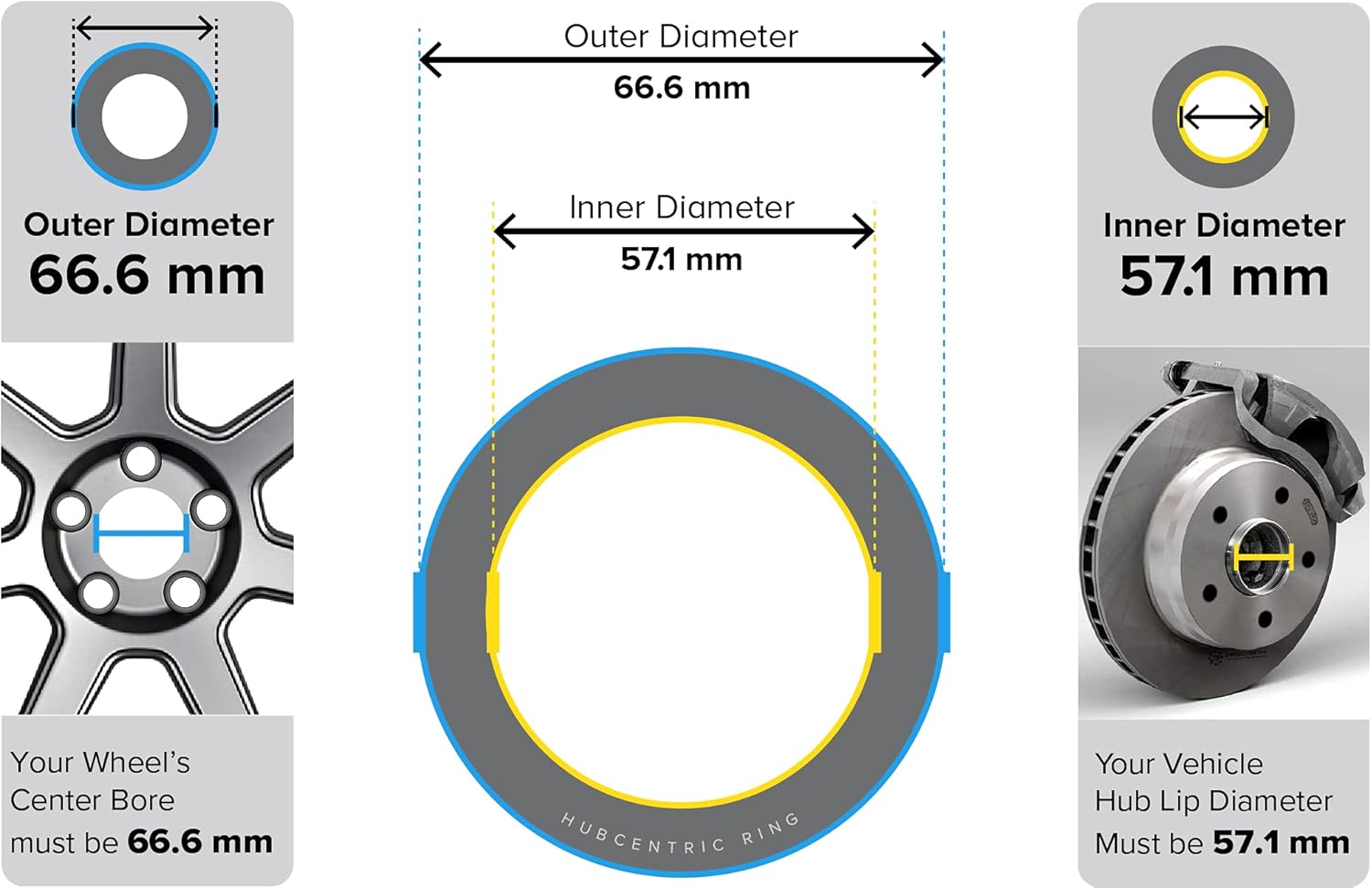



Product Overview
Crafted from high-grade CNC-machined aluminum, this set of 4 hub centric rings by StanceMagic adapts wheels with a 66.6 mm center bore to vehicle hubs measuring 57.1 mm. These rings are built to offer precise wheel alignment, superior durability, and a vibration-free ride.
Best For
- Performance-oriented drivers
- European vehicles like Audi, VW, BMW
- Those who frequently swap wheels or tires
Key Features & Benefits
- CNC-machined aluminum construction for precise fit
- Stronger than plastic; ideal for high-heat, high-load use
- Corrosion-resistant and long-lasting
- Effectively eliminates vibration at highway speeds
Pros & Cons:
- Exceptional durability and heat resistance
- Maintains tight fit over time
- Ideal for spirited or long-distance driving
- Slightly more expensive than plastic options
- May seize onto the hub if not lubricated
- Heavier than plastic variants
Who Should Buy These?
Drivers with European cars who demand precision, performance, and longevity will benefit most. These rings are perfect for those who want an upgrade over plastic options without sacrificing ease of installation or wheel stability.
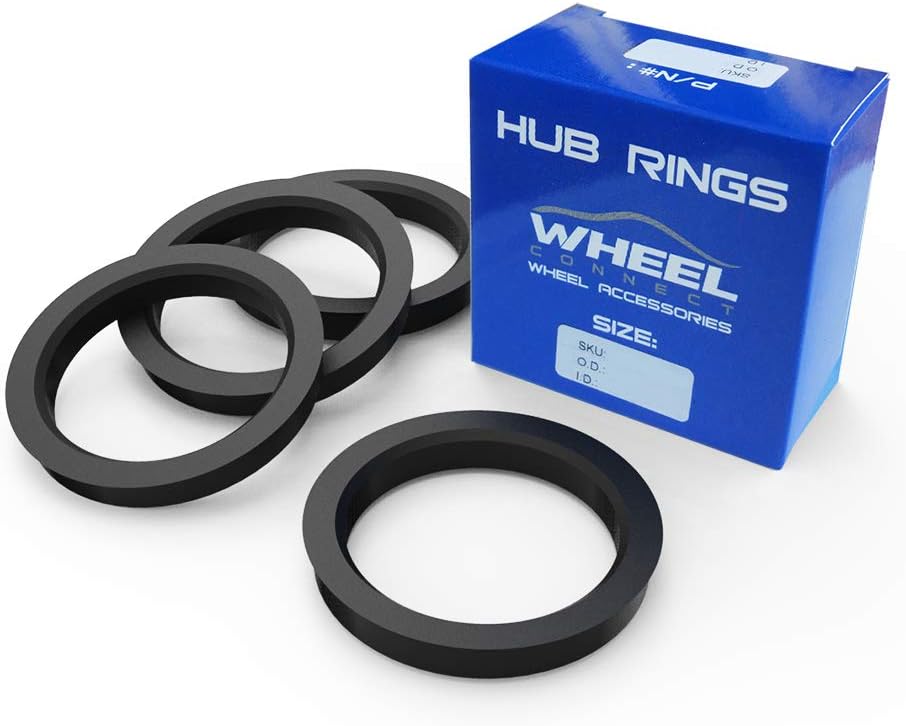 Various angles show the lip and profile for universal fitment clarity.
Various angles show the lip and profile for universal fitment clarity. 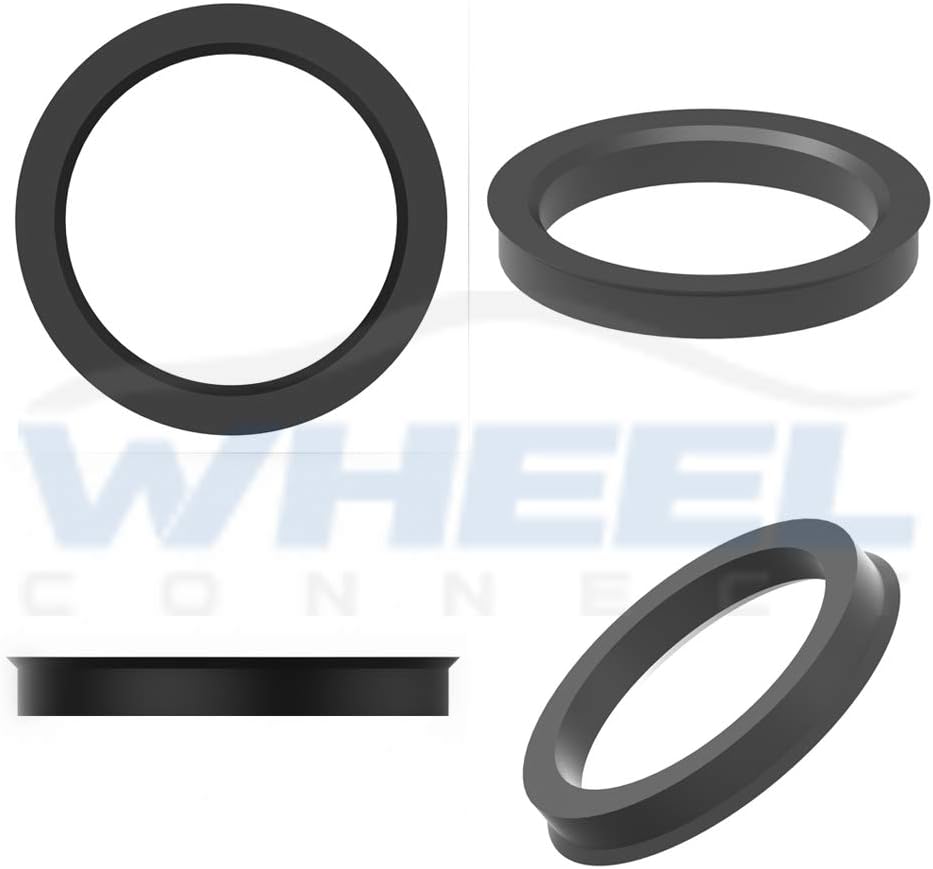 Image depicts hands measuring rings with a tiered calibration gauge.
Image depicts hands measuring rings with a tiered calibration gauge. 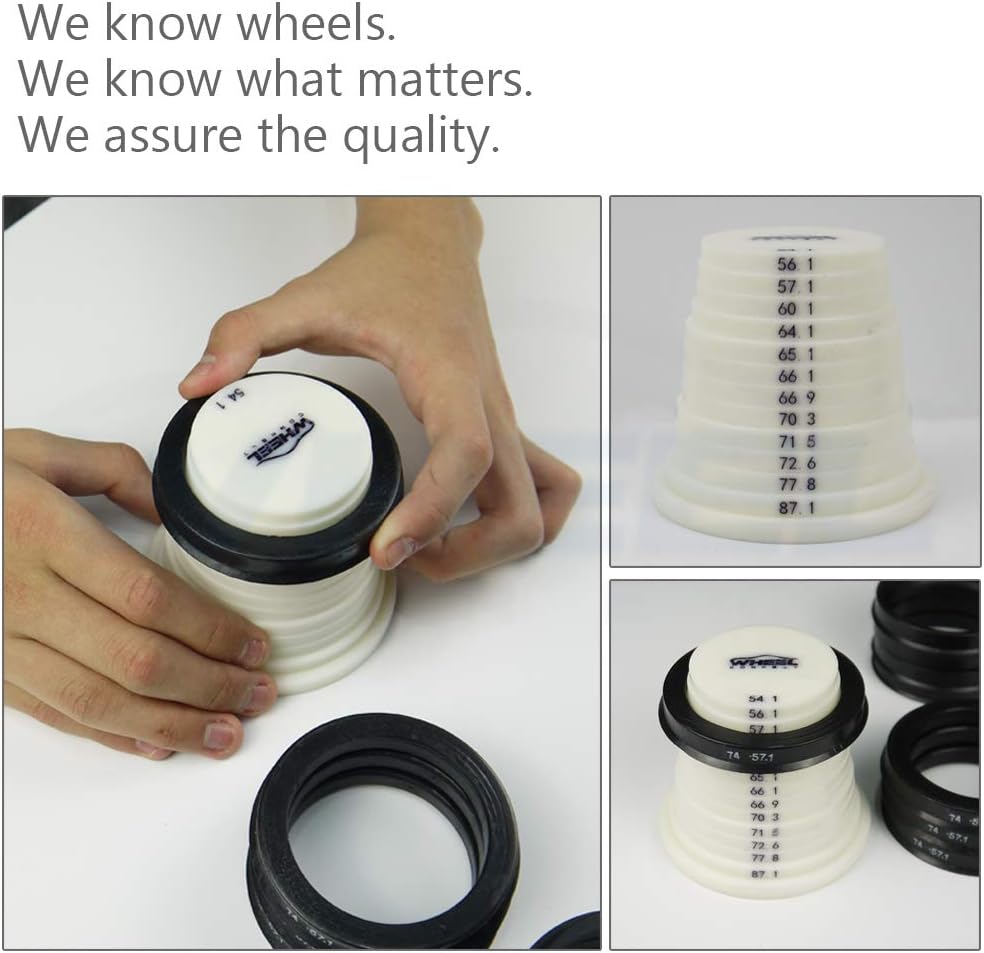



Product Overview
This plastic set of 4 hub centric rings from WHEEL-CONNECT adapts a 73.1 mm wheel bore to a 66.1 mm hub, delivering a snug, secure fit. Designed with simplicity and practicality in mind, these rings are an affordable solution to steering wheel vibration and wheel imbalance.
Best For
- Everyday drivers
- Mild climate conditions
- Vehicles with occasional wheel changes
Key Features & Benefits
- Lightweight and weather-resistant plastic material
- Easy to snap into place during installation
- Smooths out ride by aligning wheel and hub
- Compatible with various aftermarket wheel brands
Pros & Cons
- Budget-friendly solution
- Simple installation—no tools required
- Helps eliminate minor vibrations
- Not ideal for high-performance applications
- Can wear or crack under repeated stress
- Less heat-resistant than metal rings
Who Should Buy These?
This product is ideal for everyday commuters looking for a simple, affordable fix to balance issues. If you drive mostly in mild conditions and don’t require constant wheel swaps, these rings are a practical and sufficient choice.
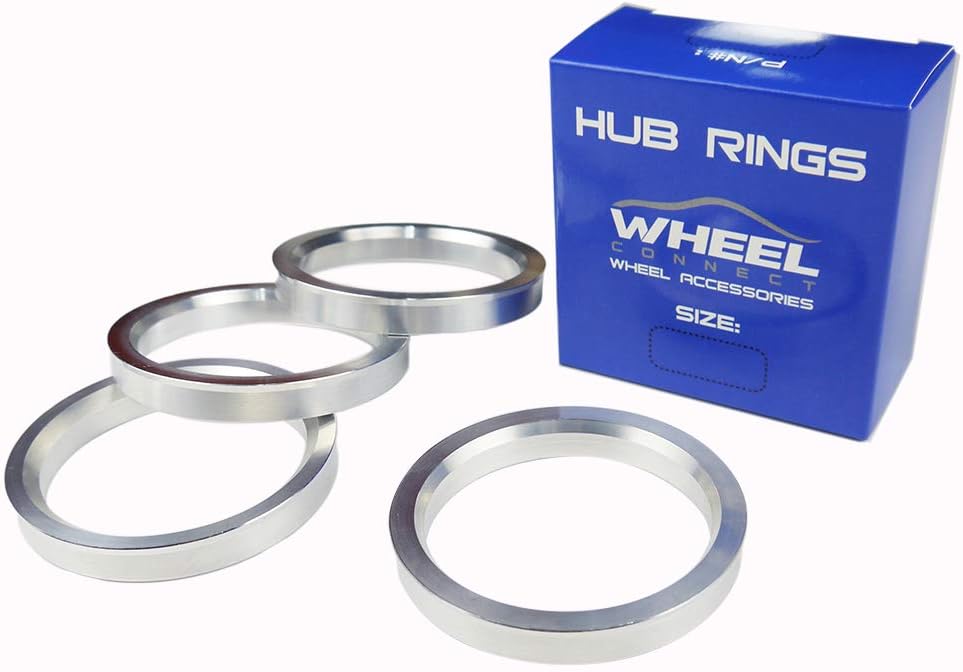 Easily fit hub rings to aftermarket wheels with visual alignment.
Easily fit hub rings to aftermarket wheels with visual alignment. 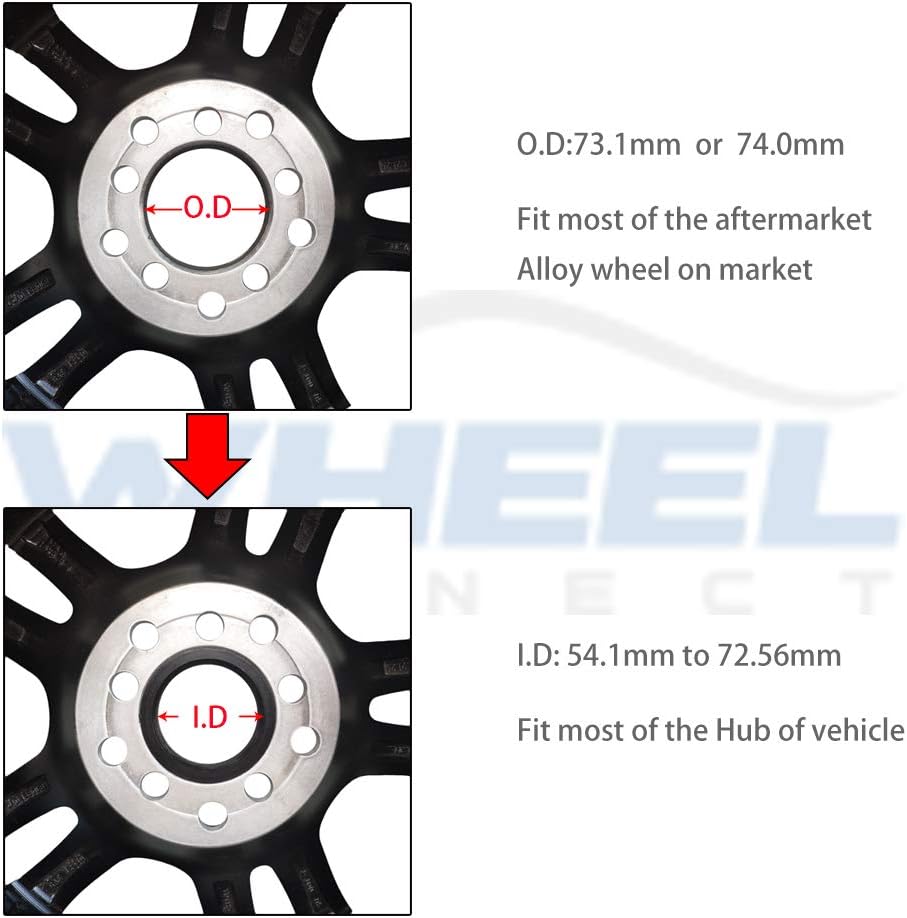 Wheel Connect’s smooth finish stands out from rough competitors.
Wheel Connect’s smooth finish stands out from rough competitors. 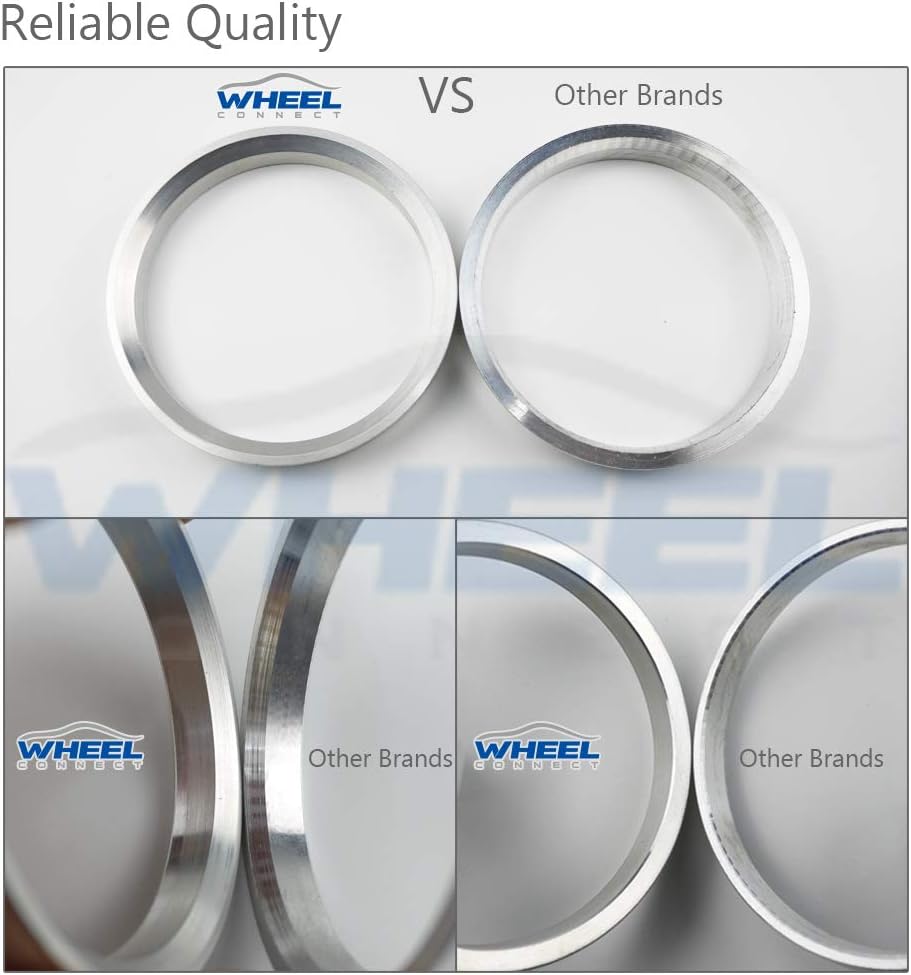



Product Overview
These WHEEL-CONNECT aluminum hubcentric rings are engineered to bridge a 73.1 mm wheel bore to a 66.1 mm vehicle hub. Designed for lasting strength and consistent wheel centering, this set of 4 is CNC-machined from solid aluminum, making it ideal for those who need reliability in demanding driving conditions.
Best For
- Performance or high-mileage drivers
- Harsh weather environments
- Vehicles needing a tight, long-term hub fit
Key Features & Benefits
- Solid aluminum construction for superior durability
- CNC-machined for high precision and fitment
- Excellent for reducing wheel vibration at high speeds
Resistant to heat, corrosion, and deformation
Pros & Cons:
- Highly durable under stress
- Better long-term value than plastic
- Ideal for spirited driving and performance setups
- Requires careful installation (aluminum can bind)
- More expensive than plastic alternatives
- May need anti-seize for easy future removal
Who Should Buy These?
If you regularly drive at high speeds, live in extreme climates, or want a long-lasting solution for your aftermarket wheels, these aluminum rings are an excellent investment. They’re perfect for owners of performance-oriented or luxury vehicles who want both form and function.
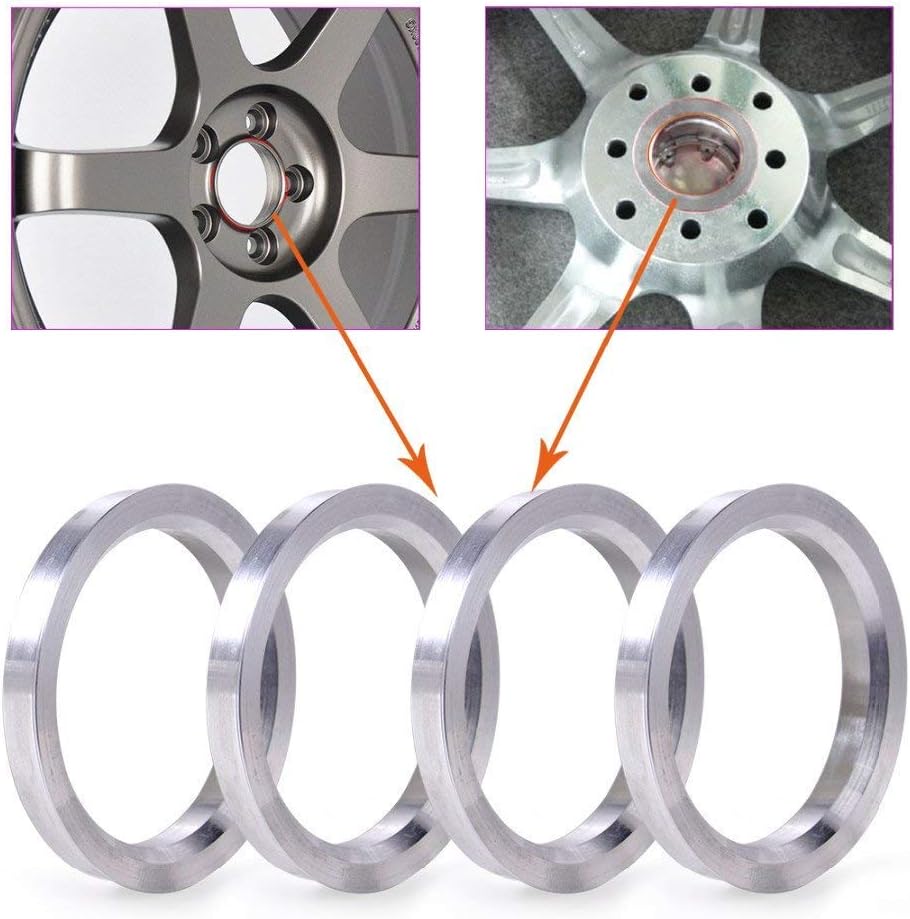 Visual guide showing hub rings seated between the wheel bore and the vehicle hub lip.
Visual guide showing hub rings seated between the wheel bore and the vehicle hub lip. 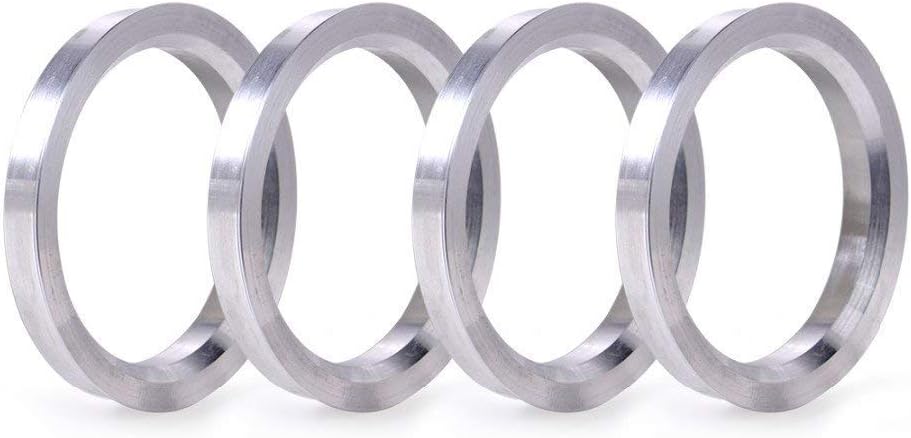 Precision measurements ensure a secure and vibration-free fit for your wheels.
Precision measurements ensure a secure and vibration-free fit for your wheels. 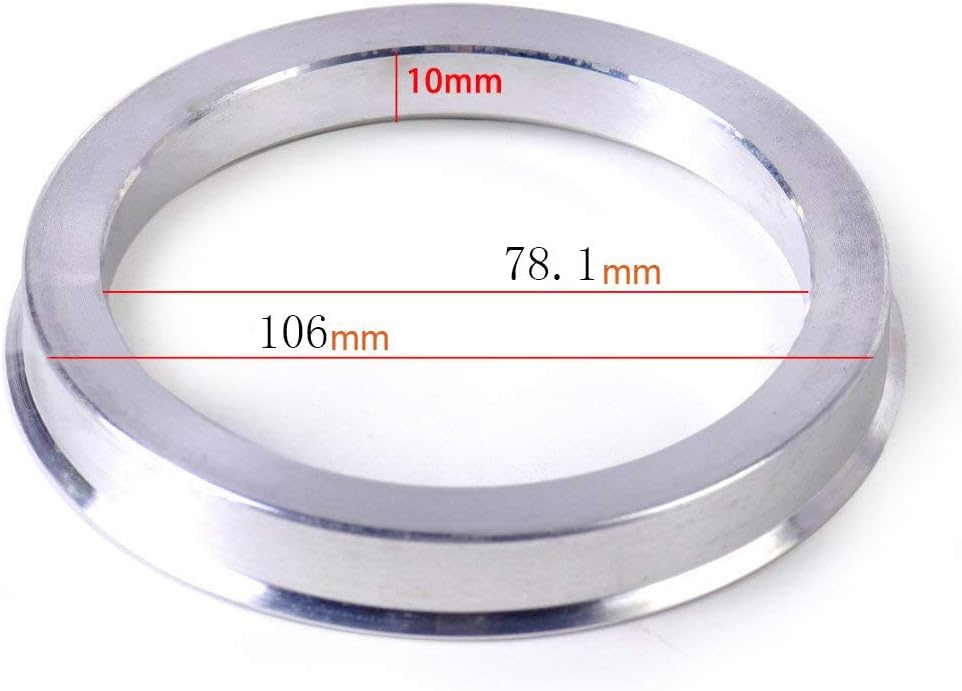



Product Overview
These ZHTEAP aluminum hubcentric rings are designed to adapt wheels with a 106 mm center bore to vehicles with a 78.1 mm hub. Built from durable aircraft-grade aluminum, this set of 4 offers unmatched fitment accuracy and long-term performance—especially for trucks, SUVs, and lifted vehicles.
Best For
- Large vehicles (e.g., trucks, SUVs, off-roaders)
- Heavy-duty and high-speed applications
- Drivers requiring oversized fitment solutions
Key Features & Benefits
- CNC-machined for an ultra-precise fit
- Made from aircraft-grade aluminum for maximum strength
- Designed to eliminate vibration in large-diameter wheels
- Excellent for aftermarket upgrades on trucks and lifted vehicles
Pros & Cons:
- Outstanding build quality and durability
- Great for high-load and off-road conditions
- Provides a tight, secure fit for large wheel bores
- Not suitable for smaller vehicles due to sizing
- Slightly heavier than average rings
- Higher price point relative to standard rings
Who Should Buy These?
These rings are ideal for serious enthusiasts driving lifted trucks, SUVs, or performance cars with oversized wheels. If you’re dealing with a 106 mm bore and want rock-solid alignment and ride stability, this is your go-to solution.
Installation Guide for Hub Centric Rings
Installing hub centric rings is a quick and simple process that doesn’t require any special tools or mechanical expertise. Whether you’re mounting new aftermarket wheels or correcting vibration issues with existing ones, following the right steps ensures a secure and effective fit.
🛠 Tools You’ll Need
- Clean rag or wire brush
- Anti-seize compound (optional for aluminum rings)
- Rubber mallet (if needed for snug fits)
- Torque wrench (for wheel lug nuts)
Step-by-Step Installation Instructions
Step 1: Clean the Hub Surface
Begin by thoroughly cleaning the hub face to remove any rust, debris, or old grease. A clean surface ensures the hub ring seats properly and evenly.
Step 2: Identify the Correct Ring
Check the size markings on your hub centric ring (e.g., 66.6 → 57.1) to ensure you have the correct inner (hub) and outer (wheel) diameter.
Step 3: Insert the Hub Ring
- For plastic rings: Gently press the ring into the back of the wheel’s center bore or the hub until it sits flush.
- For aluminum rings: Apply a small amount of anti-seize compound around the hub to prevent the ring from sticking over time. Then, fit the ring snugly.
Step 4: Mount the Wheel
Align the wheel with the hub, making sure it slides over the hub ring evenly. The ring should help center the wheel perfectly.
Step 5: Tighten the Lug Nuts
Install the lug nuts by hand in a star pattern to ensure even pressure. Then, use a torque wrench to tighten them to the manufacturer’s recommended torque specification.
Step 6: Recheck After Driving
After driving 50–100 km (or ~30–60 miles), recheck the lug nut torque. This ensures everything remains secure as the components settle.
✅ Common Mistakes to Avoid
- Using the wrong size ring: Always double-check both hub and wheel bore measurements.
- Forcing the ring: If it doesn’t fit smoothly, it may be the wrong size or the hub surface may be dirty.
- Skipping anti-seize: With aluminum rings, skipping this can lead to sticking or corrosion.
Final Thoughts & Expert Recommendations
If you’re experiencing vibration, uneven tire wear, or simply want a more stable ride after installing aftermarket wheels, hub centric rings are a small investment with big results. They ensure your wheels are perfectly centered on your vehicle’s hub, providing a smoother, safer, and more enjoyable driving experience.
Key Takeaways:
- Always measure both your hub and wheel bore sizes accurately before purchasing.
- Plastic rings are great for casual drivers in normal conditions.
- Aluminum rings are ideal for high-performance use, heavy vehicles, or extreme climates.
- Proper installation is critical—clean your hub, double-check fitment, and torque your wheels correctly.
🏆 Expert Picks Recap:
| Product | Best For |
| Hubcentric Rings (64.1 → 73.1 mm – Plastic) | Budget-conscious daily driving |
| StanceMagic Aluminum (57.1 → 66.6 mm) | Precision fitment for performance vehicles |
| WHEEL-CONNECT Plastic (73.1 → 66.1 mm) | Lightweight, casual use |
| WHEEL-CONNECT Aluminum (73.1 → 66.1 mm) | Mid-range upgrade with lasting strength |
| ZHTEAP Aluminum (106 → 78.1 mm) | Heavy-duty vehicles and oversized wheels |
✅ Our Recommendation:
If you’re looking for durability and long-term value, StanceMagic Aluminum Rings are a top choice for most drivers. For heavy vehicles, the ZHTEAP Aluminum Rings offer the most robust solution. If budget is a concern, you can still achieve a great ride with WHEEL-CONNECT or polycarbonate options.
📌 Where to Buy
All the products featured are available on Amazon with real customer reviews and competitive pricing. Use the links in this article to check availability and current deals.
Frequently Asked Questions About Hub Centric Rings
1. Do hub centric rings really eliminate vibration?
Yes—when properly sized and installed, hub centric rings align the wheel with the hub, ensuring a true, centered fit. This greatly reduces or completely eliminates steering wheel vibration, especially at highway speeds.
2. Are hub centric rings necessary if my wheels already fit?
If your aftermarket wheels have the same center bore size as your hub, then no, hub centric rings aren’t needed. However, if there’s any gap between the hub and the wheel, rings are highly recommended to ensure safety and ride comfort.
3. What’s better: plastic or aluminum hub centric rings?
- Plastic rings are more affordable, lightweight, and rust-proof, making them ideal for casual drivers in mild climates.
- Aluminum rings offer better durability and heat resistance, making them better suited for performance driving or harsh conditions.
Choose based on your vehicle usage, climate, and driving habits.
4. Can I drive without hub centric rings on aftermarket wheels?
Technically, yes—but you may experience steering wheel shake, increased wear on your suspension, and a less comfortable ride. For aftermarket wheels that are lug-centric (not hub-centric by default), driving without rings is not recommended.
5. How do I know which size hub centric ring I need?
You need two exact measurements:
- The vehicle’s hub diameter (inner ring size)
- The wheel’s center bore (outer ring size)
These can often be found in your car’s manual, online fitment guides, or by measuring with calipers. The hub centric ring must precisely match both.
6. Do hub centric rings affect alignment or wheel balance?
No—hub centric rings do not interfere with your vehicle’s alignment or wheel balancing. In fact, they enhance wheel centering, which can indirectly improve ride quality and help maintain proper alignment by reducing vibration-induced wear.





